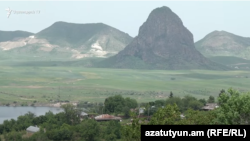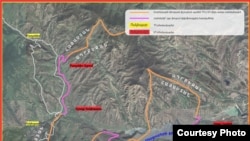RFE/RL’s Armenian Service has learned that people in the villages of Kirants and Baghanis, in particular, blocked traffic at sections of the road linking their villages to the towns of Ijevan and Noyemberian, respectively.
Some residents of Voskepar, another Armenian village that is going to be affected by the planned border demarcation, claimed, meanwhile, that what was officially announced by the authorities on Friday contradicted what Prime Minister Nikol Pashinian said when he held a closed-door meeting with residents in the village earlier this week. They said they would gather in the village on Saturday to decide on their further steps.
Following the eighth round of talks between Armenian Deputy Prime Minister Mher Grigorian and his Azerbaijani counterpart Shahin Mustafayev that was held at an undisclosed section of the Armenian-Azerbaijani border on April 19 the parties announced a preliminary agreement that the initial stage of the delimitation process will involve sections between four villages in the territory of Armenia’s Tavush province and four abandoned villages that used to be part of Azerbaijan’s Qazax district in the Soviet times.
Thus, Armenia agreed to return the four abandoned border villages that it has controlled since the early 1990s to Azerbaijan as the initial step in defining the frontier between the two South Caucasus nations.
The delimitation on the mentioned sections is to be completed by the middle of May, the parties agreed.
Residents of border villages in Tavush are particularly concerned that the demarcation of the border with Azerbaijan in accordance with the Soviet-era configuration will deprive them of access to their farmlands and complicate their communication with the rest of the country due to the fact that some parts of the road in the area will fall under Azerbaijani control.
Besides, they voice concerns that Armenia’s withdrawal from its current military positions will make the local civilians far more vulnerable to Azerbaijani armed attacks.
The Armenian Prime Minister’s Office provided explanations on Friday, addressing some of the concerns of residents of borderline communities.
“For the first time, there will be a demarcated state border between our countries [Armenia and Azerbaijan] in the section of the four villages,” it said, as quoted by Armenia’s state-run Armenpress news agency.
“Let’s note that Azerbaijan is very close to those villages even today and they are under direct fire. Yes, as a result of this process, the border guard service of Azerbaijan will get closer to the villages of Kirants and Voskepar, but their villages and ours will be separated by a delimitated state border. This is a key factor and let’s not forget that the border protection will be carried out by the border guards of the Republic of Armenia. In addition, there are many details of providing security, which will also be discussed and detailed in the near future,” Pashinian’s Office said.
It acknowledged that “a few hundred meters of the road outline” will have to be changed in the section of the village of Kirants, which it said “is not something difficult and will be implemented within a few months.”
“But this is not the only road for Kirants. The Kirants-Acharkut-Ijevan road will be repaired, maybe rebuilt as well. We mean, Kirants also has an alternative road, and practically there are no major problems,” the premier’s office said.
“It is also important to record that the Commissions agreed that in the entire process of border delimitation between Armenia and Azerbaijan, they will rely on the 1991 Alma Ata Declaration, which is recorded as a fundamental principle of the border delimitation process,” it stressed.
Meanwhile, the deal was touted as another success of the government in Azerbaijan.
“Armenia has agreed to return four villages under occupation since the early 1990s,” Azerbaijani Foreign Ministry spokesman Aykhan Hajizada wrote on social media, describing it as a “long-awaited historic event.”
The agreement between Armenia and Azerbaijan was hailed by the United States and the European Union.
On Saturday, U.S. Secretary of State Antony Blinken wrote on X (formerly Twitter): “We welcome the announcement that Armenia and Azerbaijan have agreed upon the 1991 Alma Ata declaration as the basis for border delimitation between the two countries. This is an important step towards concluding a durable and dignified peace agreement.”
Earlier, on Friday, Toivo Klaar, the EU’s Special Representative for the South Caucasus and the Crisis in Georgia, wrote on X: “Encouraging news today regarding the work of the Armenian and Azerbaijani border commissions and the start of a delimitation process based on legal documents and the 1991 Almaty Agreement.”
“The EU fully supports the process of negotiations and the aim of a comprehensive and lasting settlement,” the EU diplomat added.

